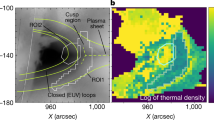Abstract
Based on data from the SONG and SPR-N multichannel hard electromagnetic radiation detectors onboard the CORONAS-F space observatory and the X-ray monitors onboard GOES satellites, we have distinguished the thermal and nonthermal components in the X-ray spectrum of an extreme solar flare on January 20, 2005. In the impulsive flare phase determined from the time of the most efficient electron and proton acceleration, we have obtained parameters of the spectra for both components and their variations in the time interval 06:43–06:54 UT. The spectral index in the energy range 0.2–2 MeV for a single-power-law spectrum of accelerated electrons is shown to have been close to 3.4 for most of the time interval under consideration. We have determined the time dependence of the lower energy cutoff in the energy spectrum of nonthermal photons E γ0(t) at which the spectral flux densities of the thermal and nonthermal components become equal. The power deposited by accelerated electrons into the flare volume has been estimated using the thick-target model under two assumptions about the boundary energy E 0 of the electron spectrum: (i) E 0 is determined by E γ0(t) and (ii) E 0 is determined by the characteristic heated plasma energy (≈5kT (t)). The reality of the first assumption is proven by the fact that plasma cooling sets in at a time when the radiative losses begin to prevail over the power deposited by electrons only in this case. Comparison of the total energy deposited by electrons with a boundary energy E γ0(t) with the thermal energy of the emitting plasma in the time interval under consideration has shown that the total energy deposited by accelerated electrons at the beginning of the impulsive flare phase before 06:47 UT exceeds the thermal plasma energy by a factor of 1.5–2; subsequently, these energies become approximately equal and are ∼(4–5) × 1030 erg under the assumption that the filling factor is 0.5–0.6.
Similar content being viewed by others
References
M. Battaglia, L. Fletcher, and A. O. Benz, Astron. Astrophys. 498, 891 (2009).
A. V. Bogomolov, Yu. I. Denisov, Yu. I. Logachev, et al., Izv. RAN, ser. Fiz. 67, 1422 (2003).
J. C. Brown, Solar Phys. 18, 489 (1971).
J. C. Brown, D. S. Spicer, and D. B. Melrose, Astrophys. J. 228, 592 (1979).
P. J. Cargill and J. A. Klimchuk, Astrophys. J. 478, 799 (1997).
Yu. I. Denisov, S. N. Kuznetsov, Yu. I. Logachev, et al., Astron. Vestnik 37, 127 (2003).
K. P. Dere, Solar Phys. 75, 189 (1982).
A. G. Emslie, Astrophys. J. 595, L19 (2003).
N. Gopalswamy, H. Xie, S. Yashiro, and I. Usoskin, in Proc. of the 29th Int. Cosmic Ray Conf. (Pune, 2005), Vol. 1, p. 169.
V. V. Grechnev, V. G. Kurt, I. M. Chertok, et al., Solar Phys. 252, 149 (2008); http://arxiv.org/abs/0806.4424.
P. C. Grigis and A. O. Benz, Astrophys. J. 683, 1180 (2008).
G.D. Holman, L. Sui, R.A. Schwartz, and A. G. Emslie, Astrophys. J. 595, L97 (2003).
S. N. Kuznetsov, A. V. Bogomolov, Yu. P. Gordeev, et al., Izv. RAN, Ser. Fiz. 59, 2 (1995).
S. N. Kuznetsov, V. G. Kurt, B. Yu. Yushkov, and K. Kudela, in Proc. of the 30th Int. Cosmic Ray Conf. (Merida, 2008), Vol. 1, p. 121.
C. H. Miklenic, A.M. Veronig, and B. Vršnak, Astron. Astrophys. 499, 893 (2009).
P. Saint-Hilaire and A. O. Benz, Astron. Astrophys. 435, 743 (2005).
G.M. Simnett, Astron. Astrophys. 445, 715 (2006).
M. Takahashi and T. Watanabe, Adv. Space Res. 25, 1833 (2000).
A. M. Veronig, J. C. Brown, B. R. Dennis, et al., Astrophys. J. 621, 482 (2005).
I. S. Veselovsky, M. I. Panasyuk, G. A. Bazilevskaya, et al., Kosmich. Issled. 42, 453 (2004).
V.V. Zharkova and M. Gordovskyy, Astrophys. J. 651, 553 (2006).
I.A. Zhitnik, Yu. I. Logachev, A.V. Bogomolov, et al., Astron. vestnik 40, 108 (2006).
Author information
Authors and Affiliations
Corresponding author
Additional information
Original Russian Text © V.G. Kurt, S.I. Svertilov, B.Yu. Yushkov, A.V. Bogomolov, V.V. Grechnev, V.I. Galkin, V.V. Bogomolov, K. Kudela, Yu.I. Logachev, O.V. Morozov, I.N. Myagkova, 2010, published in Pis’ma v Astronomicheskiĭ Zhurnal, 2010, Vol. 36, No. 4, pp. 292–303.
Rights and permissions
About this article
Cite this article
Kurt, V.G., Svertilov, S.I., Yushkov, B.Y. et al. Dynamics and energetics of the thermal and nonthermal components in the solar flare of January 20, 2005, based on data from hard electromagnetic radiation detectors onboard the CORONAS-F satellite. Astron. Lett. 36, 280–291 (2010). https://doi.org/10.1134/S1063773710040067
Received:
Published:
Issue Date:
DOI: https://doi.org/10.1134/S1063773710040067



